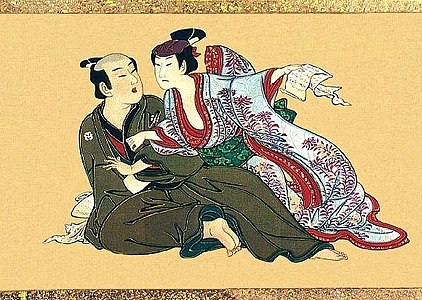Miyagawa Isshō
Miyagawa Isshō | |
|---|---|
宮川 一笑 | |
| Born | 1689 |
| Died | January 20, 1780 (aged 90) |
| Style | ukiyo-e |
Miyagawa Isshō (宮川 一笑, 1689 – 20 January 1780) was a Japanese painter in the ukiyo-e style, primarily depicting kabuki actors, geisha, sumo wrestlers, and other elements of everyday urban culture. He used several other names: Fujiwara Andō (藤原 安道), Kohensai (湖辺斎) and others; his common name was Kiheiji (喜平治).[1]
The majority of Isshō's works that survive come from the Kyōhō era (1716–1736). He was a pupil of Miyagawa Chōshun (1682–1752),[2] who, in turn, was influenced by the works of Hishikawa Moronobu. Like many ukiyo-e artists, Isshō also produced a number of shunga, paintings of erotic scenes.
Isshō was banished from Edo in 1751, along with his master Chōshun, to the island of Niijima off the Izu Peninsula for a year.[1] This came after a dispute arose over the payment for a painting commission in Nikkō. A Kanō school artist commissioned Chōshun to paint some of the walls of the Nikkō Tōshō-gū but refused or was unable to pay. In the ensuing confrontation, the Kanō artist and two others were killed by Isshō and Chōshun's son.[2] Isshō was never pardoned and died on 20 January 1780.[2][1]
Selected works
[edit]-
Miyagawa Isshō painting. Untitled.
-
From the Spring Pastimes series.
-
From the Spring Pastimes series.
References
[edit]- ^ a b c British Museum.
- ^ a b c Japan Ukiyo-e Association 1982, p. 54.
Works cited
[edit]- Japan Ukiyo-e Association (1982). Genshoku Ukiyo-e Dai-Hyakka Jiten 原色 浮世絵大百科事典 第6巻 [Original Colour Grand Ukiyo-e Encyclopaedia]. Vol. 6. Taishūkan Publishing.
- "Miyagawa Issho (宮川一笑) (Biographical details)". British Museum. Retrieved 7 June 2018.
See also
[edit] Media related to Miyagawa Isshō at Wikimedia Commons
Media related to Miyagawa Isshō at Wikimedia Commons




